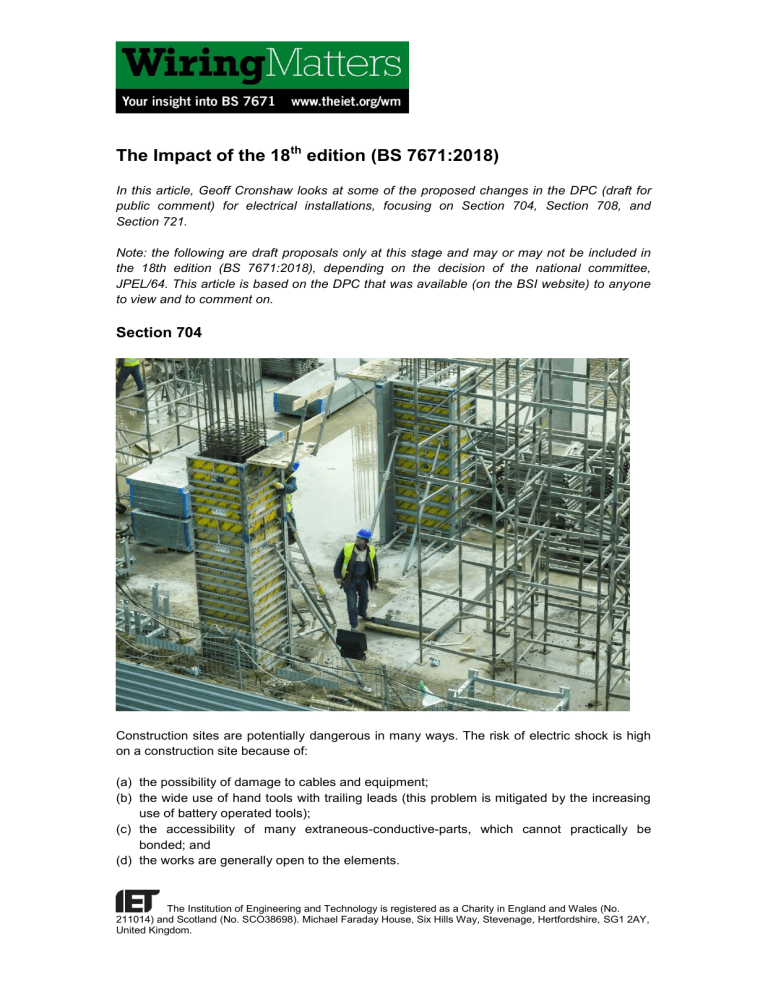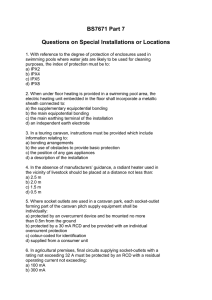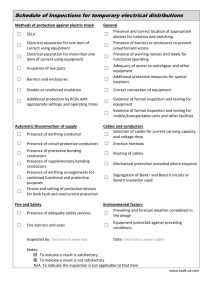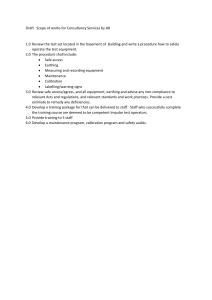
The Impact of the 18th edition (BS 7671:2018) In this article, Geoff Cronshaw looks at some of the proposed changes in the DPC (draft for public comment) for electrical installations, focusing on Section 704, Section 708, and Section 721. Note: the following are draft proposals only at this stage and may or may not be included in the 18th edition (BS 7671:2018), depending on the decision of the national committee, JPEL/64. This article is based on the DPC that was available (on the BSI website) to anyone to view and to comment on. Section 704 Construction sites are potentially dangerous in many ways. The risk of electric shock is high on a construction site because of: (a) the possibility of damage to cables and equipment; (b) the wide use of hand tools with trailing leads (this problem is mitigated by the increasing use of battery operated tools); (c) the accessibility of many extraneous-conductive-parts, which cannot practically be bonded; and (d) the works are generally open to the elements. The Institution of Engineering and Technology is registered as a Charity in England and Wales (No. 211014) and Scotland (No. SCO38698). Michael Faraday House, Six Hills Way, Stevenage, Hertfordshire, SG1 2AY, United Kingdom. Section 704 prescribes particular measures to reduce the risks caused by this harsh environment. The DPC on the 18th edition (BS 7671:2018) contains a number of small changes, including requirements for external influences, and modifications to Regulation 704.410.3.6 concerning the protective measures of obstacles, placing out of reach and electrical separation. Protection against electric shock General requirements BS 7671 strongly prefers the reduced low voltage system to supply portable hand lamps for general use and portable hand tools and local lighting up to 2 kW, while safety extra low voltage (SELV) is strongly preferred for portable hand lamps in confined or damp locations. Section 704 prohibits the protective measures of obstacles and placing out of reach (Section 417), non-conducting location (Regulation 418.1), and earth-free local equipotential bonding (Regulation 418.2). In addition Section 704 now makes it clear that electrical separation for the supply of more than one item of current-using equipment (418.3) shall not be used. Automatic disconnection of supply – PME It is usually impracticable to comply with the bonding requirements of the Electricity Safety, Quality and Continuity Regulations on construction sites for PME. Hence the DPC of BS 7671:2018 states that a PME earthing facility shall not be used for the means of earthing for an installation falling within the scope of this Section unless all extraneous-conductive-parts are reliably connected to the main earthing terminal. See Regulation 704.411.3.1. Please note Section 704 does not apply to installations in administrative locations of construction sites (for example, offices and canteens). Wiring systems Cables on a construction site location should preferably not be installed across walkways or site roads as they are susceptible to mechanical damage. If cables are installed in this manner they require the appropriate level of mechanical protection. External influences A new regulation (705.512.2) now requires consideration to be given to the risk of damage to electrical equipment by corrosive substances, movement of structures and vehicles, wear and tear, tension, flexing, impact, abrasion, severing, and ingress of liquids or solids. Inspection and testing It is recommended that the maximum period between inspections of construction site installations is 3 months – as detailed in IET Guidance Note 3. The Institution of Engineering and Technology is registered as a Charity in England and Wales (No. 211014) and Scotland (No. SCO38698). Michael Faraday House, Six Hills Way, Stevenage, Hertfordshire, SG1 2AY, United Kingdom. IET Guidance Note 7 gives recommendations for RCD testing on construction sites. Fixed installation RCDs should additionally be tested daily (using the integral test button). Should RCDs be used to protect mobile equipment they must be tested by the operative before each period of use (again, using the integral test button) and by the responsible person every 3 months (using an RCD tester). An RCD is a protective device used to automatically disconnect the electrical supply when an imbalance is detected between live conductors. In the case of a single-phase circuit, the device monitors the difference in currents between the line and neutral conductors. If a line to earth fault develops, a portion of the line conductor current will not return through the neutral conductor. The device monitors this difference, operates and disconnects the circuit when the residual current reaches a preset limit, the residual operating current (IΔn). Safety services Section 704 now mentions in a Regulation 704.56 note that site conditions may require the provision of safety services such as escape lighting. See also the IET publication “Electricians Guide to Emergency Lighting. Section 708 caravan/camping parks The particular requirements of Section 708 apply to the electrical installations in caravan/camping parks and similar locations providing connection points for supplying leisure accommodation vehicles (including caravans) and tents. The scope of Section 708 has been extended to cover circuits intended to supply residential park homes in caravan parks and camping parks and similar locations. In addition, changes have been made to socket-outlet requirements, RCD protection, and external influences. Protection against electric shock General requirements As you would expect, the protective measures of obstacles, placing out of reach, nonconducting location and protection by earth-free local equipotential bonding are not permitted. These measures are contained in Sections 417 and 418 of BS 7671:2008 and are not for general application. The protective measures of Section 417 provide basic protection only and are for application in installations controlled or supervised by skilled or instructed persons. The fault protective provisions of Section 418 are special and, again, subject to control and effective supervision by skilled or instructed persons. The Institution of Engineering and Technology is registered as a Charity in England and Wales (No. 211014) and Scotland (No. SCO38698). Michael Faraday House, Six Hills Way, Stevenage, Hertfordshire, SG1 2AY, United Kingdom. Protective multiple earthing As stated in Regulation 708.411.4, the Electricity Safety, Quality and Continuity Regulations 2002 (ESQCR) prohibits the connection of a PME earthing facility to any metalwork in a leisure accommodation vehicle (including a caravan). This does not preclude the use of a PME earthing facility as the means of earthing for other purposes, such as to the installations of permanent buildings. External influences Any wiring system or equipment selected and installed must be suitable for its location and able to operate satisfactorily without deterioration. Suitable protection must be provided, both during construction and for the completed installation. Regarding presence of solid foreign bodies, a minimum degree of protection of IP4X is now required. Regarding presence of water, a minimum degree of protection of IPX4 is required. Equipment must now be protected against mechanical impact IK 08 (see BS EN 62262) and/or located to avoid damage by any reasonable foreseeable impact. Caravan pitch socket-outlets The requirements for socket-outlets have been redrafted to prevent the socket contacts being live when accessible. Regulation 708.55.1.1 requires that every socket-outlet or connector shall either comply with: (a) BS EN 60309-2 and shall be interlocked and classified to Clause 6.1.5 of BS EN 603091:1999 to prevent the socket contacts being live when accessible; or (b) be part of an interlocked self-contained product complying with BS EN 60309-4 and classified to Clauses 6.1.101 and 6.1.102 of BS EN 60309-4:2006 to prevent the socket contacts being live when accessible. The current rating is to be no less than 16 A but may be greater if required. At least one socket-outlet should be provided for each caravan pitch. Where socket-outlets are grouped in pitch supply equipment, there should be one socket-outlet for each pitch limited to a group of four. Overcurrent protection Every socket-outlet shall be individually protected by an overcurrent protective device, in accordance with the requirements of Chapter 43 of BS 7671. A fixed connection for a supply to a mobile home or residential park home shall be individually protected by an overcurrent protective device, in accordance with the requirements of Chapter 43. The Institution of Engineering and Technology is registered as a Charity in England and Wales (No. 211014) and Scotland (No. SCO38698). Michael Faraday House, Six Hills Way, Stevenage, Hertfordshire, SG1 2AY, United Kingdom. Isolation Regulation 708.536.2.1.1 now requires at least one means of isolation to be installed in each distribution enclosure. This device shall disconnect all live conductors. RCD protection Each socket-outlet must be protected individually by an RCD having the characteristics specified in Regulation 415.1.1 for additional protection. The RCD must disconnect all live conductors including the neutral. Requirements for RCD protection have been extended to cover supplies to residential park homes. A final circuit (from the metering point) intended for the fixed connection for a supply to a mobile home or a residential park home shall be individually protected by an RCD having a rated residual operating current not exceeding 30 mA accessible to the consumer. Devices selected shall disconnect all live conductors. PME As mentioned previously the ESQCR prohibit the connection of a PME earthing facility to any metalwork in a leisure accommodation vehicle (caravan). If the caravan supply is derived from a permanent building that is supplied by a PME system then the caravan supply will have to be part of a TT system having a separate connection to Earth independent from the PME earthing. The separation of the earthing can be effected at the main distribution board. IET Guidance Note 7 provides detailed information in Figure 7.1. This enables the exposed-conductive-parts connected to each system to be more readily identified and inspected periodically. An earth electrode for the TT system should be provided nearby and located so that the resistance areas of the PME supply earthing and earth electrode do not overlap. Alternatively, the separation of the earthing can be made at the caravan pitch supply points. In this instance, earth electrodes will be required at these points. Again IET Guidance Note 7 provides detailed information in Figure 7.2. The Institution of Engineering and Technology is registered as a Charity in England and Wales (No. 211014) and Scotland (No. SCO38698). Michael Faraday House, Six Hills Way, Stevenage, Hertfordshire, SG1 2AY, United Kingdom. Section 721 caravans and motor caravans The particular requirements of Section 721 apply to the electrical installations of caravans and motor caravans at nominal voltages not exceeding 230/440 V a.c. or 48 V d.c. Note there are some exclusions. This Section contains a number of changes including requirements for electrical separation, RCDs, proximity to non-electrical services, and protective bonding conductors. Protective equipotential bonding Regulation 721.411.3.1.2 requires structural metallic parts that are accessible from within the caravan to be connected through main protective bonding conductors to the main earthing terminal within the caravan. The requirements for connections of protective bonding conductors have been clarified. Regulation 721.544.1.1 states that the terminations of protective bonding conductors connecting the conductive structure of the unit shall be accessible and protected against corrosion. Provision of RCDs The requirements for RCD protection have also been redrafted. The Institution of Engineering and Technology is registered as a Charity in England and Wales (No. 211014) and Scotland (No. SCO38698). Michael Faraday House, Six Hills Way, Stevenage, Hertfordshire, SG1 2AY, United Kingdom. Regulation 721.415.1 states that where protection by automatic disconnection of supply is used, a residual current device with a rated residual operating current not exceeding 30 mA, complying with BS EN 60947-2 (Annex B), BS EN 61008-1, BS EN 61009-1 or BS EN 62423 breaking all live conductors, shall be provided having the characteristics specified in Regulation 415.1.1. Each supply inlet shall be directly connected to its associated RCD. Please note this implies that there may not be any taps or junctions in this connection. Proximity to non-electrical services The requirements for proximity to non-electrical services have been redrafted. Regulation 721.528.2.1 requires that where cables have to run through a gas cylinder storage compartment, they shall pass through the compartment at a height of not less than 500 mm above the base of the cylinders and shall be protected against mechanical damage by installation within a conduit system complying with the appropriate part of the BS EN 61386 series or within a ducting system complying with the appropriate part of the BS EN 50085 series. Switchgear and controlgear The installation to the caravan should have a main disconnector, which will disconnect all the live conductors. This should be placed in a suitable position for ready operation within the caravan to isolate the supply. When a caravan only has one final circuit then the isolation can be afforded by the overcurrent protective device as long as it fulfils the requirements for isolation. An indelible notice in the appropriate language(s) must be permanently fixed near the main isolation point inside the caravan to provide the user with instructions on connecting and disconnecting the supply (refer to Figure 721 of BS 7671). The inlet to the caravan must be an appliance inlet complying with BS EN 60309-1. This should be installed not more than 1.8 m above ground level, in a readily accessible position, have a minimum degree of protection of IP44, and should not protrude significantly beyond the body of the caravan. The connecting flexible cable The means of connecting the caravan to the pitch socket-outlet should be provided with the caravan. This must have a plug at one end complying with BS EN 60309-2 and a flexible cable with a continuous length of 25 m (±2 m). The connecting flexible cable must be in one length, without signs of damage, and not contain joints or other means to increase its length; and a connector if needed that is compatible with the appropriate appliance inlet. The cable should be to the harmonized code H05RN-F The Institution of Engineering and Technology is registered as a Charity in England and Wales (No. 211014) and Scotland (No. SCO38698). Michael Faraday House, Six Hills Way, Stevenage, Hertfordshire, SG1 2AY, United Kingdom. (BS EN 50525-2-21) or equivalent, include a protective conductor, have cores coloured as required by Table 51 of BS 7671 and have a cross-sectional area as shown in Table 721. Periodic inspection and testing The purpose of periodic inspection and testing is to provide an engineering view on whether or not the installation is in a satisfactory condition where it can continue to be used safely. Periodic inspection and testing is necessary because all electrical installations deteriorate due to a number of factors such as damage, wear and tear, corrosion, excessive electrical loading, ageing and environmental influences. IET Guidance Note 3 gives the recommended initial frequencies for inspection of electrical installations for construction sites, caravan/camping parks, and in caravans. Conclusion It is important to be aware that this article only gives a brief overview of requirements for electrical installations on construction sites, caravan/camping parks, and in caravans. Please refer to BS 7671 for more information. This article only gives an overview of draft proposals, which may or may not be included in the 18th edition (BS 7671:2018), depending on the decision of the national committee, JPEL/64. The Institution of Engineering and Technology is registered as a Charity in England and Wales (No. 211014) and Scotland (No. SCO38698). Michael Faraday House, Six Hills Way, Stevenage, Hertfordshire, SG1 2AY, United Kingdom.







